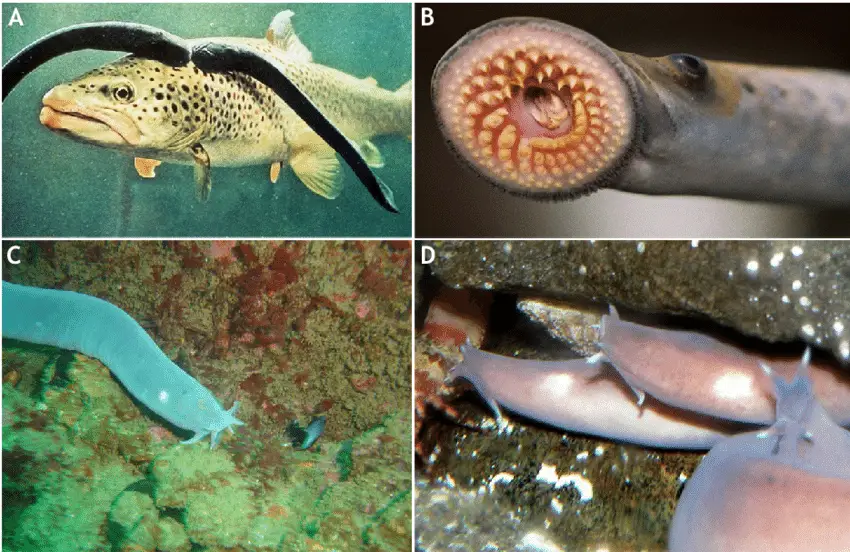Class Cyclostomata contain fish like jawless Vertebrate with a circular mouth, lamprey and Hagfish are two groups of this class. Class Cyclostomata have around 50 species of Hagfish and lamprey, they can be classified into different subclass, orders,s, and families based on the similarities and dissimilarities among them.
As the members of this class have a circular mouth they are known as Cyclostomata, all the members of class Cyclostomata can be divided into two orders, order Petromyzontiformes and order Myxiniformes, order Petromyzontiformes include lamprey and Myxiniformes include Hagfish.

Order 1: Petromyzontiformes:
The term Petromyzontiformes has a special significance, the members of Petromyzontiformes built nests with stone and their buccal funnel attached to the stony nest, the name Petromyzontiformes formed of two different Greek words, Petros means stone and myzon means suck. In this order lamprey are placed, they are also popular with the name sand pride, Lamers eel, lamperns.
- Mouth present ventrally at the centre of the cup shaped buccal funnel, the buccal funnel form the sucker, around the mouth horny conical yellowish epidermal teeth arranged in radial pattern.
- The external nostrils present on the head dorsally, nostril is single, the nasohypophyseal sac is not connected to the pharynx, it is closed at posterior end.
- On lateral side seven pairs of external gill slits present, the gill slits are connected to the gill pouches and respiratory pharynx internally through internal gill slits.
- Paired appendages absent, unpaired appendages present in the form of gill, the dorsal fin is well developed and supported by gill rays.
- The gill slits and gill pouches are supported by a cartilaginous tissues known as gill basket.
- The ribbon like flat spinal cord give spinal nerve, the spinal nerve have separate dorsal and ventral roots.
- The auditory organ have internal ear, each internal ear have two vertical semicircular canals.
- Members of the order Petromyzontiformes found in both marine water as well as fishes water, specially during spawn they migrate to freshwater.
- Fertilization is external in the water, the female members release large numbers of small eggs, development is indirect, include a fish like larval stage, the larval stage is very long.

Order Petromyzontiformes have around 30 species, some important examples of this order are, Petromyzon, Ichthyomyzon, Entospherus, Lampetra.
Order 2: Myxiniformes:
The term Myxiniformes contains the Greek word myxa which refers to the slime, members of this order produce a large amount of slime, they include Hagfish, members of the order Myxiniformes all are exclusively marine.
- The mouth open terminally, the mouth surrounded by four pairs of tentacls and very few teeth. Myxiniformes do not show any suctorial buccal funnel as seen in Petromyzontiformes.
- The external nostrils open outside terminally on the head, the nasohypophyseal sac is not closed behind, it open into pharynx through nasohypophyseal duct.
- Number of gill pouches is around 6 to 15 pairs, the gill pouches open outside through 1 to 15 pairs.
- The dorsal fin is not strong as Petromyzontiformes, the dorsal fin is weak or remain absent.
- The supporting endoskeletal structure in gill system, the branchial basket is poorly developed.
- The dorsal and ventral roots of spinal cord are not separate, the dorsal and ventral roots join together.
- The auditory organ of Myxiniformes have only one semicircular canal.
- The female Myxiniformes release limited number of large sized eggs, the development is direct do not include any larval stage.
In order Myxiniformes around 15 species are present, they are marine, some important examples of this order are, Paramyxine, Myxine, Eptatretus.

Order Petromyzontiformes and order Myxiniformes show great dissimilarity between them, they show very little similarity between them and the reason for those little similarities may be due to the convergence evolution.
Reference Cyclostomata General Characteristics Features Classifications Systematic Position Affinities
Detailed Study On
Characteristics Features of Cyclostomata
Economic Importance of Petromyzon
Nervous System and Excretory System of Petromyzon
Respiratory System and Circulatory System of Petromyzon
Digestive System and Feeding Mechanism of Petromyzon
Anatomy of Petromyzon (Lamprey)
Hi Everyone!!! Welcome to Imaluop. Imaluop always try to learn some new and he want to share to other people. Here we will try to learn various topics on Science, specially on Biological Sciences.